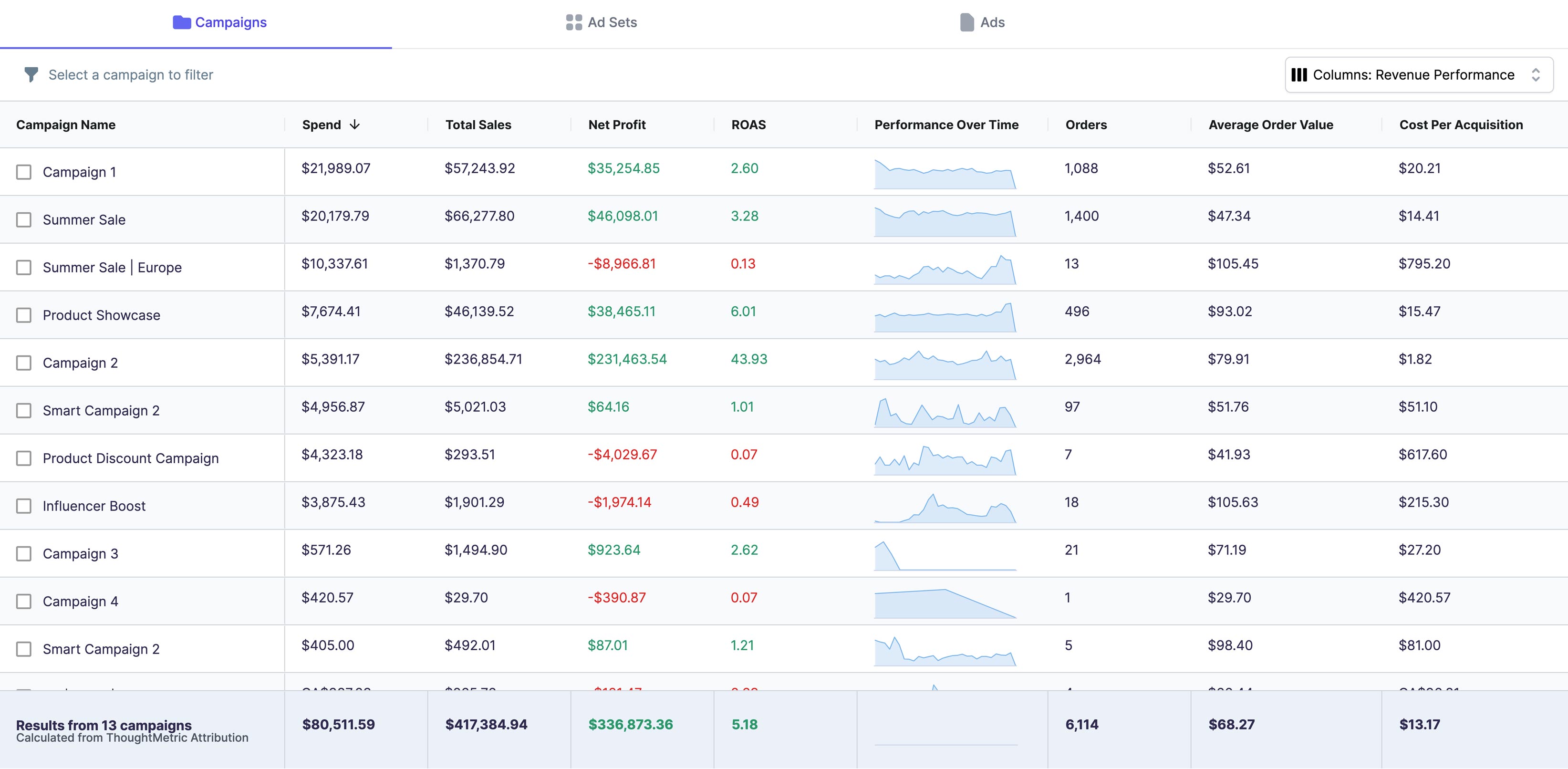In e-commerce, marketing attribution is essential. Platforms like ThoughtMetric and Triple Whale help businesses understand which efforts truly drive revenue. But with so many options, how do you determine the right fit for your business? Let's dive into a direct comparison.
What is ThoughtMetric?
Key features and benefits of ThoughtMetric include:
5 Different Attribution Models: ThoughtMetric provides a variety of multi-touch attribution models, including first touch, last touch, linear paid, position-based, and a recommended multi-touch model. This flexibility allows businesses to align attribution with their marketing goals, offering a complete customer journey view.
Campaign Performance Analysis: ThoughtMetric provides in-depth tools to analyze campaign performance across channels, pinpointing which campaigns effectively drive traffic, engagement, and sales. You can view key metrics at the campaign, ad set, and ad level, offering granular performance insights.
Product Analytics: Track performance at the SKU level to see which products drive the most revenue, attract new vs. returning customers, and perform best across each channel.
Creative Performance Analysis: ThoughtMetric helps you analyze the effectiveness of your ad creatives, ensuring you're investing in visuals and messaging that resonate with your audience and drive conversions.
Customer Analytics: ThoughtMetric provides insights into customer behavior, journey paths, and purchase drivers. This information supports the development of targeted marketing strategies and contributes to improved customer lifetime value.
Server-Side Tagging: ThoughtMetric uses server-side tagging to bypass issues caused by iOS 14 updates and ad blockers, ensuring more accurate and dependable data collection.
What is Triple Whale?
Key features and aspects of Triple Whale include:
More Complex and Higher Pricing: Triple Whale's pricing structure is more intricate, based on two factors: Gross Merchandise Volume (GMV) and different feature tiers. This means the cost can vary significantly depending on your revenue and the level of features you require. Not all features are included in every tier.
AI Moby Agents: Triple Whale leverages "Moby Agents." AI-powered assistants that automate complex analyses, detect potential issues, and answer data-related questions. This is not included in every plan.
Marketing Mix Modeling (MMM): Marketing Mix Modeling is a statistical analysis technique that evaluates the impact of various marketing activities (both online and offline) on sales and other business outcomes, factoring in external influences like seasonality and economic conditions. This is not included in every plan.
Comparison Chart
Conclusion
Choosing between ThoughtMetric and Triple Whale ultimately depends on your specific business needs and budget.
- ThoughtMetric is an excellent choice for businesses looking for a user-friendly, straightforward, and transparent attribution solution with clear pricing.
-
Triple Whale, on the other hand, is geared towards businesses that require more in-depth data analysis, advanced AI-driven insights, and Marketing Mix Modeling.
FAQs
Q: What is the main difference between ThoughtMetric and Triple Whale?
A: ThoughtMetric focuses on user-friendly, transparent, and comprehensive e-commerce attribution with all features included in its pageview-based pricing. Triple Whale offers more complex, advanced data analysis, including AI tools and Marketing Mix Modeling, with tiered, GMV-based pricing where not all features are included in every plan.
Q: Which platform is easier to use?
A: ThoughtMetric is designed to be more user-friendly with an intuitive dashboard, making complex data accessible. Triple Whale is generally considered more complex, catering to those seeking deeper analysis.
Q: How does pricing compare between ThoughtMetric and Triple Whale?
A: ThoughtMetric has simple, pageview-based pricing where all features are available to every paying customer. Triple Whale's pricing is more complex, based on Gross Merchandise Volume (GMV) and different feature tiers, meaning features vary by plan.
Q: Are all features included in ThoughtMetric's plans?
A: Yes, ThoughtMetric's transparent pricing model ensures all paying customers have access to every feature, regardless of their specific plan.



.png)
.png)